Margarita Snails
(Margarites pupillus)
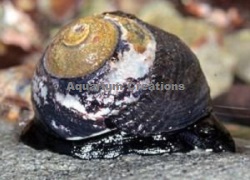
Description:
Margarita snails are extremely popular to aquarist's because they will consume large quantities of algae including hair algae.
Unlike some saltwater snails Margarita snails are non-venomous therefore they won’t damage delicate corals and other invertebrates. They do quite well in reef environments,
and when flipped over they and continue on their way. Features include a smooth turban-like shell with slight iridescence. The shell is a silver-grey color and may have a covering of purple or pink coralline algae.
Finally Hermit crabs aren't interested in Margarita shells, so they are safe from predation. Reef-safe, growing only to a maximum size of 1" as an adult they will never outgrow their home.
Tank Recommendations:
Keep Margarita Snails with peaceful fish and in a tank with algae growth to graze on. For this reason they do best in mature tanks
with well established live rock. Coming from the Pacific Ocean Margarita snails require water temperatures no higher than 78 degrees. Margarita's are moderately easy to keep as long as you watch your temperatures,
refrain from using copper based medications and keep an eye on the levels of soluble waste since all saltwater snails are sensitive to nitrates.
Can they Right Themselves if they Get Upside-down?: Yes
Food and diet:
Keep in mind that the Margarita Snail will starve if algae levels become sparse. Therefore, supplement their diet with dried seaweed. To feed, use an algae
clip or wrap the seaweed around a rock or empty shell and place into your aquarium, next to the glass. To promote shell growth, supplement calcium levels in your aquarium.
Recommended Quantity:
1 per 6 gallons
Level of Care:
Moderately easy
Reef Compatibility
:Excellent
Approximate Purchase Size:
1/2" to 3/4"
Important Acclimation Notes:
Margarita snails are sensitive to changes in water parameters including pH, temperature, and alkalinity. They need to be slowly acclimated to their new home using the drip method explained
on our website for a minimum of 3 hours.
|
Price Each $1.99
Pack of 10 $9.99
|
Astrea Snails
Astraea tecta
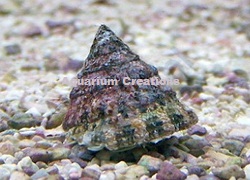
Description:
Astraea snails are native to the Caribbean; they are a smaller snail, only reaching about one inch once fully matured. They are 100% reef safe and a good
all around saltwater cleaner snail with a great appetite. They favor hair algae, but will also consume green or brown film algae, diatoms, and Cyano. Astreas are good all around snail, a good addition
to any tank especially those that suffer from hair algae outbreaks. Keep an eye on your reef aquarium for any upside down Astrea snails and if you find any move them from the sand bed to a place on your rock. If they fall off their glass or
live rock into the sand they are not able to right themselves and will eventually die. According to Julian Sprung's Reef Aquarium Manual , Volume One, Astrea snails are the ideal
snail to be placed in your aquarium as soon as ammonia and nitrite levels reach acceptable levels (less than 1 ppm). One of the best snails for controlling Diatom's, (light brown/red algae),
Green Algae Blooms and Dark Purple/Red Slime algae . Astrea snails are easily identified based on the characteristic sharp conical shell circled by a large ridge. Once acclimated to their
new surroundings Astrea snails are quite hardy.
Tank Recommendations:
Keep Astrea Snails with peaceful fish and in a tank with algae growth to graze on. Coming from the Caribbean, Astrea snails are excellent for tanks that run on the warm side.
Once well acclimated the astrea snail can handle water temperatures up to a maximum of 83 degrees but lower temperatures are definitely recommended. Astrea snails are moderately easy to keep as long as you
refrain from using copper based medications and keep an eye on the levels of soluble waste since all saltwater snails are sensitive to nitrates.
Can they Right Themselves if they Get Upside-down?: No
Food and diet:
Keep in mind that the Astrea Snail will starve if algae levels become sparse. Therefore, supplement their diet with dried seaweed. To feed, use an algae
clip or wrap the seaweed around a rock or empty shell and place into your aquarium, next to the glass. To promote shell growth, supplement calcium levels in your aquarium.
Recommended Quantity:
1 per 6 gallons
Approximate Purchase Size:
1/2" to 3/4"
Important Acclimation Notes:
Astrea snails are sensitive to changes in water parameters including pH, temperature, and alkalinity. They need to be slowly acclimated to their new home using the drip method explained
on our website for a minimum of 3 hours.
|
Price Each $1.99
Pack of 12 $22.69 (1.89 ea.)
Pack of 25 $44.79 (1.79 ea.)
Pack of 50 $84.50 (1.69 ea.)
Pack of 100 $159.00 (1.59 ea.)
|
Nassarius Snails
Nassaurius vibex
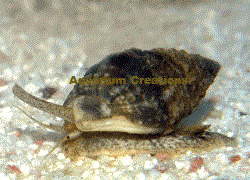
The Nassarius vibex is a little clean up critter that does a BIG JOB.
Description:
The Nassarius Vibex is a little worker with a big appetite. With a hunger for all the garbage on the bottom of the tank,
such as organic waste, leftover food, fish excrement, all are eaten by the small Nassarius vibex snail. Since it's this waste throughout the aquarium that causes
Nitrates to rise, having Nassarius vibex snails in your aquarium that eliminate this waste will keep Nitrates lower. The small Nassarius vibex are found in portions of the Atlantic, Gulf of Mexico and Caribbean Sea.
If the cleaning capabilities are not enough, other advantages of the Nassarius vibex is the important aeration of the substrate which prevents the sand from compacting and the fact that this constant stirring of the
sand puts micro particulates in the water for coral to feed upon. Normally you will not see much of the Nassarius vibex but that will change when you feed your tank. Then the small cleaners will emerge as you feed and will pick up the left
over food.
Tank Recommendations:
Nassarius vibex snails are moderately easy to keep as long as you keep them in a live sand bed, refrain from using copper based medications and keep an eye on the levels of soluble waste since all saltwater snails are sensitive to nitrates.
Can they Right Themselves if they Get Upside-down?: Yes
Recommended Quantity:
1 or 2 per gallon
Food and diet:
Nassarius Vibex Snails can typically find enough food in saltwater reef aquariums. If you feel there may not be enough food simply supplement their diet with frozen meaty foods, such as brine shrimp, mysis shrimp, or tiny pieces of fish or scallop.
Level of Care: Easy
Reef Compatibility:Excellent
Approximate Purchase Size:1/4" to 3/8"
Important Acclimation Notes:
Nassarius snails are sensitive to changes in water parameters including pH, temperature, and alkalinity. They need to be slowly acclimated to their new home using the drip method explained
on our website for a minimum of 3 hours.
|
Price Each $1.99
Pack of 12 $22.69 (1.89 ea.)
Pack of 25 $44.75 (1.79 ea.)
Pack of 50 $84.50 (1.69 ea.)
Pack of 100 $149.00 (1.49 ea.)
|
Large Cerith Snails
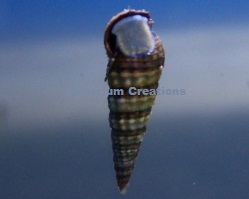
Description:
The Cerith Snail is a terrific multipurpose snail. It will feed on many things. The Cerith is one of the snails that's an omnivore so it will eat detritus, uneaten fish food, green or brown film algae, diatoms and cyano. It will bury itself in the sand as it goes looking for food so it is a great sand sifter. Many aquarist's overlook the Cerith snail because they don't see it working while they watch but the real reason is that they are in fact a true nocturnal critter and does all their cleaning work while everyone else sleeps; Cerith Snails are the perfect snail for established aquariums to handle routine cleaning, and excellent for newer tanks to keep various new tank issues in check.
Tank Recommendations:
Large Cerith snails are moderately easy to keep as long as you keep them in a live sand bed, refrain from using copper based medications and keep an eye on the levels of soluble waste since all saltwater snails are sensitive to nitrates.
Can they Right Themselves if they Get Upside-down?: Yes
Food and diet:
They can be fed pellet foods if the reef tank is very new and you are concerned they may not find enough natural food.
Recommended Quantity:
1 per 6 gallons
Level of Care: Moderately Easy
Reef Compatibility:Excellent
Approximate Purchase Size: 1"
Important Acclimation Notes:
Cerith snails are sensitive to changes in water parameters including pH, temperature, and alkalinity. They need to be slowly acclimated to their new home using the drip method explained
on our website for a minimum of 3 hours.
|
Price Each $2.79
Pack of 12 $32.28 (2.69 ea.)
Pack of 25 $66.25 (2.65 ea.)
Pack of 50 $129.50 (2.59 ea.)
Pack of 100 $250.00 (2.50 ea.)
|
Nerite Snails
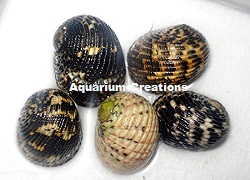
Elliminates cyano bacteria
(red slime) & other
film algaes on glass, rock or sand.
Description:
The Nerite Snail, Nerita tessellata, are very hardy and will survive a long time in the home aquarium. Their black shells protect them from predators. Unlike other snails
these guys will NOT die by flipping over, they can easily flip themselves upright when needed! At a maximum size of around 1
inch, these outstanding cleaners are found on a number of reefs scattered throughout the Indo-Pacific region. They will eat unwanted
nuisance algaes such as cyanobacteria (red slime) and other film algaes that may occur on the glass, rock or sand. These eager
eaters desire several types of micro algae commonly found in the home aquarium.
Tank Recommendations:
Nerite Snails come from the Caribbean so are excellent for tanks that run on the warm side. Once well acclimated the Nerite snail can handle water temperatures up to a maximum of 82 degrees but lower temperatures are definitely recommended. Nerite snails are moderately easy to keep as long as you refrain from using copper based medications and keep an eye on the levels of soluble waste since all saltwater snails are sensitive to nitrates.
Can they Right Themselves if they Get Upside-down?: Yes
Food and diet:
Keep in mind that the Nerite Snail will starve if algae levels become sparse. Therefore, supplement their diet with dried seaweed. To feed, use an algae
clip or wrap the seaweed around a rock or empty shell and place into your aquarium, next to the glass. To promote shell growth, supplement calcium levels in your aquarium.
Recommended Quantity:
1 per 6 gallons
Approximate Purchase Size:
1/2" to 3/4"
Important Acclimation Notes:
Nerite snails are sensitive to changes in water parameters including pH, temperature, and alkalinity. They need to be slowly acclimated to their new home using the drip method explained
on our website for a minimum of 3 hours.
|
Price Each $1.99
Pack of 12 $23.75 (1.97 ea.)
Pack of 25 $47.25 (1.89 ea.)
Pack of 50 $89.50 (1.79 ea.)
Pack of 100 $169.00 (1.69 ea.)
|
Mexican Turbo Snails
Turbo fluctuosa
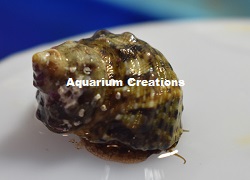
Description:
Mexican Turbo snails are referred to as grazers because of their voracious appetites for several types of micro algae found in the home aquarium.
Turbo snails are great for battling green hair algae. At the same time, these snails will bulldoze loose rocks and may rearrange your aquarium.The Mexicaan Turbo Snail is native
to the Gulf of California off the coast of Mexico. Very popular among reef aquarium hobbyists. Gram for Gram, Mexican Turbo Grazer's clean more nuisance algae ounce for ounce than
any other snail. They do a great job on ridding a tank of hair algae and other nuisance algaes scouring the entire saltwater aquarium, top to bottom. They do have the problem though
of not being able to right their self back up if they fall over and onto their backs, they may die after a while if they aren't righted. Make sure to have rubble in the sand bed so
they can right themselves, and avoid keeping turbo snails with aggressive fish that may intentionally flip them over. Pure work horses, the Mexican Turbo's radula, or tongue, of the
snail has a rasp like texture. When pulled across a surface, this rasp pulls the algae loose for a quick snack. Also known as the Turban or Top Shell Snail, Turbo fluctuosa has a thick
turban-shaped shell with an irridescent interior.
Tank Recommendations:
Keep Mexican Turbo Snails with peaceful fish and in a tank with algae growth to graze on. For this reason they do best in mature tanks with well established live rock. Coming from the Pacific Ocean Mexican Turbo snails require water temperatures no higher than 78 degrees. Mexican Turbo's are moderately easy to keep as long as you watch your temperatures, refrain from using copper based medications and keep an eye on the levels of soluble waste since all saltwater snails are sensitive to nitrates.
Can they Right Themselves if they Get Upside-down?: Yes
Food and diet:
Keep in mind that the Mexican Turbo Snail will starve if algae levels become sparse. Therefore, supplement their diet with dried seaweed. To feed, use an algae
clip or wrap the seaweed around a rock or empty shell and place into your aquarium, next to the glass. To promote shell growth, supplement calcium levels in your aquarium.
Recommended Quantity:
1 per 10 gallons
Level of Care:
Moderately easy
Reef Compatibility
:Excellent
Approximate Purchase Size:
1" to 1-1/2"
Important Acclimation Notes:
Mexican Turbo snails are sensitive to changes in water parameters including pH, temperature, and alkalinity. They need to be slowly acclimated to their new home using the drip method explained
on our website for a minimum of 3 hours.
|
Price Each $1.99
Pack of 12 $22.75 (1.89 ea.)
Pack of 25 $44.75 (1.79 ea.)
Pack of 50 $84.50 (1.69 ea.)
Pack of 100 $159.00 (1.59 ea.)
|







